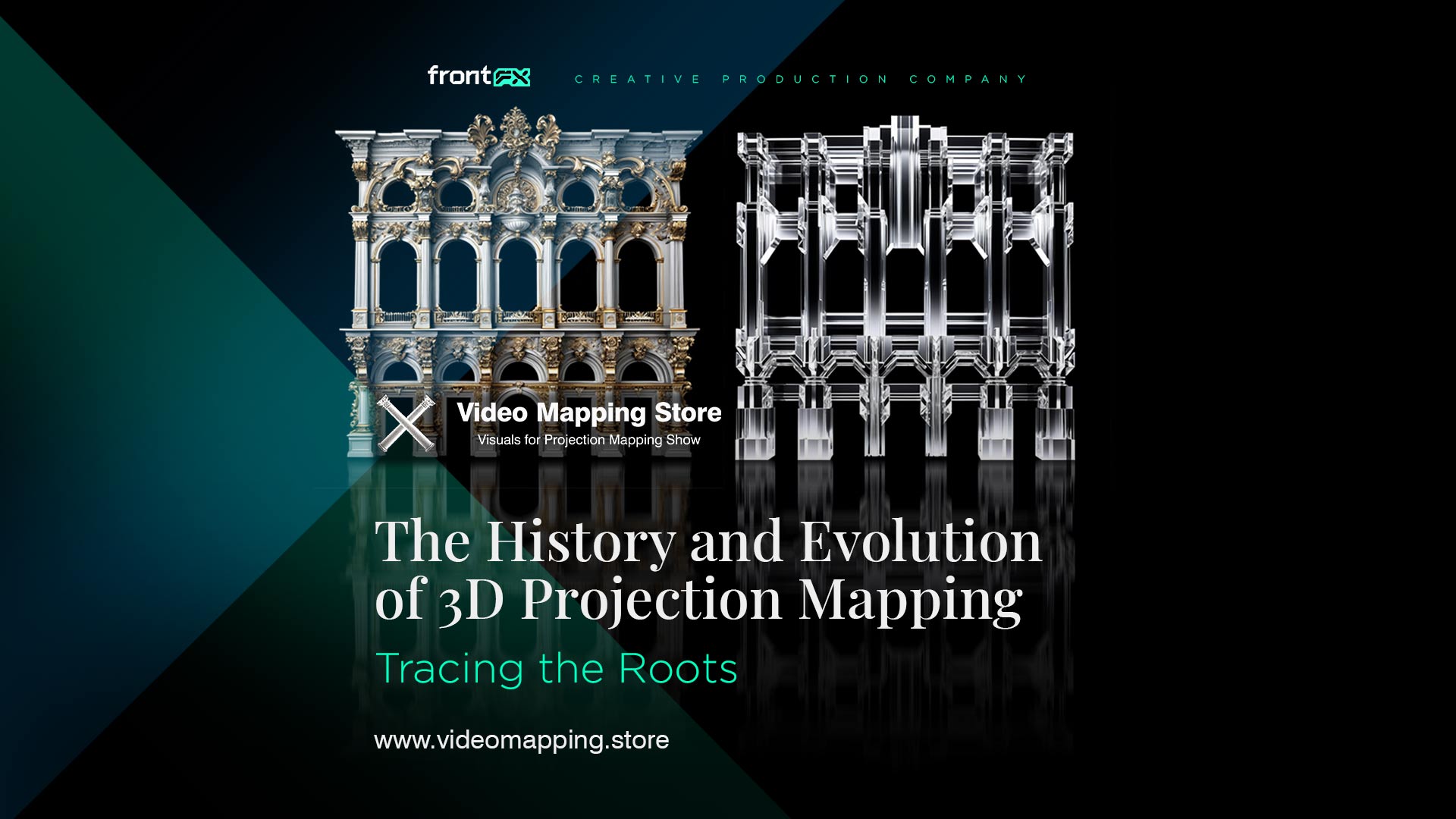Tracing the Roots: A Look at the History of 3D Projection Mapping
I. Introduction
- Definition of 3D projection mapping
- Brief overview of the history and evolution of the technology
II. Early Forms of Projection Mapping
- Use of slides and film projections in the early 20th century
- Development of video projection technology in the 1970s
III. Birth of 3D Projection Mapping
- Introduction of computer-generated imagery (CGI) in the 1980s
- Development of software for 3D projection mapping in the 1990s
IV. Advancements in 3D Projection Mapping
- Expansion of the use of 3D projection mapping in events and marketing
- Increased use of 3D projection mapping in the arts and entertainment industry
- Development of projection mapping software and hardware
V. Future of 3D Projection Mapping
- Potential for further advancements in technology and creative applications
- Potential impact on various industries
VI. Conclusion
- Recap of the history and evolution of 3D projection mapping
- Summary of current state and future potential of the technology
Introduction
3D projection mapping is a technology that allows users to project video or animated content onto irregularly shaped surfaces, creating the illusion of three-dimensional space. It has become a popular tool for events and marketing campaigns, as well as for use in the arts and entertainment industry. In this article, we will explore the history and evolution of 3D projection mapping, from its early beginnings to its current state and future potential.
Early Forms of Projection Mapping
The use of projection technology dates back to the early 20th century, when slides and film projections were used for educational and entertainment purposes. These early forms of projection mapping were limited to the projection of flat, two-dimensional images onto flat surfaces.
In the 1970s, video projection technology was developed, which allowed for the projection of moving images. This marked a significant advancement in projection mapping, as it allowed for the projection of dynamic, real-time content. However, these early forms of projection mapping were still limited to the projection of flat, two-dimensional images onto flat surfaces.
It wasn’t until the introduction of computer-generated imagery (CGI) in the 1980s that the concept of 3D projection mapping began to take shape. With the ability to create and manipulate three-dimensional objects on a computer, the potential for projecting these virtual objects onto physical surfaces became a possibility. However, it wasn’t until the development of specialized software in the 1990s that 3D projection mapping as we know it today became a reality.
Birth of 3D Projection Mapping
The birth of 3D projection mapping can be traced back to the introduction of computer-generated imagery (CGI) in the 1980s. With the ability to create and manipulate three-dimensional objects on a computer, the potential for projecting these virtual objects onto physical surfaces became a possibility. However, it wasn’t until the development of specialized software in the 1990s that 3D projection mapping as we know it today became a reality.
One of the early pioneers in 3D projection mapping was Bart Kresa, who is credited with creating some of the first 3D projection mapping displays in the late 1990s. Using custom software and hardware, Kresa was able to project detailed, animated 3D graphics onto complex, irregularly shaped surfaces such as buildings and sculptures. This groundbreaking technology quickly gained attention and sparked the interest of other artists and designers who saw the potential for creative expression through 3D projection mapping.
The development of software for 3D projection mapping in the 1990s was a major milestone in the evolution of the technology. Prior to this, projection mapping was limited to the projection of flat, two-dimensional images onto flat surfaces. With the development of software that could manipulate and project three-dimensional objects, the creative possibilities for projection mapping expanded significantly.
As 3D projection mapping technology continued to advance, it became more accessible and began to be used in a variety of applications, including events and marketing campaigns, as well as in the arts and entertainment industry. It has since become a popular tool for creating immersive and interactive experiences that engage and captivate audiences.
Advancements in 3D Projection Mapping
As 3D projection mapping technology continued to evolve and become more accessible, it began to be used in a variety of applications, including events and marketing campaigns, as well as in the arts and entertainment industry. The expansion of the use of 3D projection mapping in events and marketing was driven in part by the technology’s ability to create immersive and interactive experiences that engage and captivate audiences. Companies and organizations began to see the value in using projection mapping as a tool to promote their brand and products, and it quickly became a popular choice for events and marketing campaigns.
The increased use of 3D projection mapping in the arts and entertainment industry was another major advancement in the evolution of the technology. Artists and designers saw the potential for using projection mapping as a way to enhance live performances and exhibitions, and it became a popular tool for creating dynamic and visually stunning experiences.
In addition to the expansion of the use of 3D projection mapping in various industries, there have also been numerous advancements in projection mapping software and hardware. These advancements have allowed for even more creative and dynamic uses of 3D projection mapping, including the ability to project onto moving objects and incorporate interactivity into displays.
Overall, the advancements in 3D projection mapping have contributed to its increasing popularity and widespread use in a variety of industries. As the technology continues to evolve and become more accessible, it is likely that we will see even more innovative and creative applications of 3D projection mapping in the future.
Future of 3D Projection Mapping
As 3D projection mapping technology continues to advance, it is likely that we will see even more innovative and creative applications of the technology. The potential for further advancements in software and hardware will likely lead to an expansion of the use of 3D projection mapping in various industries. It is also possible that 3D projection mapping will continue to blur the lines between the physical and digital worlds, creating even more immersive and interactive experiences for audiences.
One potential area of growth for 3D projection mapping is in the field of virtual and augmented reality. As these technologies continue to evolve, there is potential for the integration of 3D projection mapping into virtual and augmented reality experiences. This could allow for even more realistic and immersive projections, as well as the ability to incorporate interactive elements into the experience.
Another possible direction for the future of 3D projection mapping is the use of the technology in more practical applications. For example, projection mapping could potentially be used to create interactive displays in public spaces, such as museums or transportation hubs, or as a tool for training and education.
Conclusion
The history and evolution of 3D projection mapping is a fascinating journey that has taken us from the early days of slides and film projections to the advanced technology we have today. With its ability to create immersive and interactive experiences, it is clear that 3D projection mapping has a bright future ahead. As the technology continues to evolve and become more accessible, we can expect to see even more creative and dynamic uses of 3D projection mapping in the years to come.
In addition to the creative and technical aspects of 3D projection mapping, there are also a number of resources available to those interested in learning more about the technology or creating their own projection mapping displays. One such resource is Video Mapping Store, which offers a variety of useful content and tools for those looking to get into 3D projection mapping.
One of the main offerings from Video Mapping Store is their collection of video mapping loops and video mapping toolkits. These are pre-made, customizable visuals that can be used to create projection mapping displays quickly and easily. The loops and toolkits are available in a range of styles and themes, making it easy to find something that fits your project’s needs.
In addition to the loops and toolkits, Video Mapping Store also offers a range of useful content and resources for those interested in 3D projection mapping. This includes tutorials and guides on how to use the various tools and software, as well as inspiration and ideas for creative applications of the technology.
Overall, Video Mapping Store is a valuable resource for those looking to get started with 3D projection mapping or take their skills to the next level. With a wide range of useful content and tools, it is a great place to find everything you need to create stunning projection mapping displays.


